You have a fantastic product or service, but your sales funnel is almost empty. Is this situation familiar to you? But you don’t need to fear because here we’ll dive into 30 incredible places to find prospects for your small business, all just waiting to discover what your business has to offer. Get ready to rev up your sales engine and supercharge your business growth!
Sales prospecting is the backbone of all sales reps. It keeps the sales funnel flowing and the sales team’s goals within reach.
As an entrepreneur, I know the struggle of finding and transforming a potential customer into a happy, paying customer. Trust me, even top-performing salespeople have had their fair share of hiccups in the getting prospects process. The key lies in understanding that a well-defined sales prospecting process and the right sales prospecting techniques can make all the difference when you identify and qualify leads.
There are countless ways to reach out to potential prospects. The possibilities are endless, from social media channels and marketing campaigns to direct mail and good old-fashioned networking.
In this blog post, we’ll delve into 30 fantastic places to find prospects and leads for your business. By the end of this post, you’ll have a treasure trove of ideas to fuel your sales prospecting efforts and propel your business forward. Let’s get started, shall we?
Leads VS. Prospects
The first question I want to respond to here is, “What are prospects in sales process?” Or, what is the difference between leads and prospects?
Let me share a secret with you. When I started my sales process, I struggled to understand the difference between them. After all, they both seem to be potential customers, right?
Well, yes, but there’s a crucial distinction between them. And this can require totally different approaches in different stages of your sales process.
In the sales process, a prospect is a potential customer who has shown interest (buying signals) in your company’s offering and is a good fit for your target audience. They’ve moved past the initial stage of your sales from simply being a lead to being a part of your sales funnel.
Related: How To Reach Your Target Audience
Prospects are typically further along in the buying decision and sales process and are more likely to become paying customers. They’ve shown buying signals, like asking questions about your product, and have the authority to make the final purchasing decision.

Sales Prospecting Process: How to Turn a Lead Into Prospect?
Now that we’ve clarified the distinction between leads and prospects let’s dive into the art of turning a lead into a prospect.
It all comes down to following a systematic approach and using your sales prospecting tools and techniques effectively. Let’s dig deeper into the processes we have designed.
Lead qualification is integral to your sales process because it ensures that companies target the right prospects and sell to those who need their products. It involves:
- assessing a lead’s financial capacity to make a purchase,
- determining if they have the authority to do so, and
- gauging their interest in buying.
The lead qualification process will help your sales team to identify and prioritize leads most likely to convert into customers (hot leads). In such a way, your sales reps will not waste resources on leads who can’t or won’t buy what you offer (unqualified leads). As a result, it is an efficient way for you to narrow your focus and make the most out of your resources.
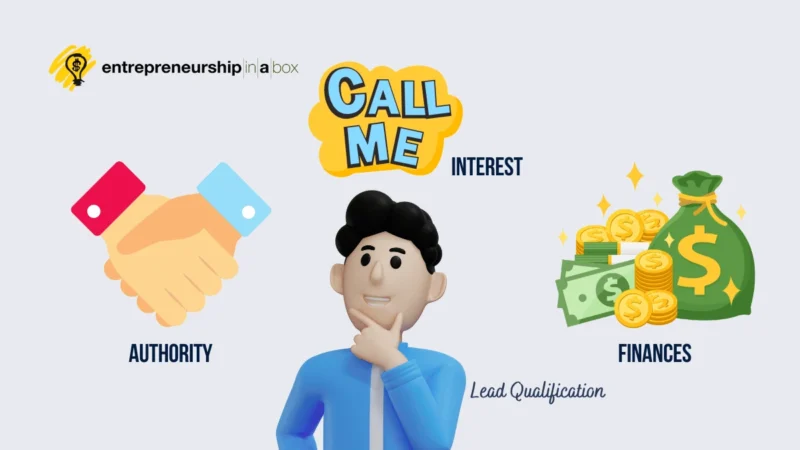
There are three levels of qualification that your sales rep will need to implement:
Organization Level Qualification
You will need to start with organization-level prospect qualification. By evaluating potential prospects based on various factors – such as their size, industry, and location – it’s possible to determine if they are a good match with your business. This process helps you tailor your solutions to meet their needs and ensure you’re targeting the right customers.
Organization-level prospect qualification will require collecting data on prospective customers, company size, industry sector, location, and budget.
Related: 9 Steps to Start a Charity
Opportunity level qualification
Opportunity-level prospect qualification assesses whether a prospective customer has an identifiable need that your product or service can fulfill and if they have the necessary resources to implement it. This qualification provides valuable insight into whether a potential buyer can benefit from your offer.
To evaluate prospects on a sales opportunity level, ask the following questions:
- What specific pain point can your product or service help them solve?
- Do they have an internal team that will use the product or service?
- Are there any budgetary or technical constraints preventing them from implementing it?
- Do they have the necessary infrastructure in place for successful implementation?
- Is there another solution already in place that could prevent them from investing?
- Are there any competitor solutions that they’re already using?
- Do they understand the value proposition of your product or service and how it will benefit their organization?
Once you have answers to these questions, you can assess whether a prospect is qualified on an opportunity level.
Stakeholder level qualification
With the stakeholder-level prospect qualification, you want to find if the company (prospective customer) you are looking to work with is a good match for what you offer them.
You can ask your prospects questions to determine if they can purchase your product:
- Do they have enough money in their budget for your solution and potential deal?
- Who else in the organization would need to be aware of this purchase decision?
- Are there some criteria the company uses to decide which products they buy, and who made up these criteria?
- What are the company’s current strategy and goals?
- How will your product or service help the company achieve its goals?
Once you have this information, it’s time to decide if your product fits them. So, evaluate their needs and determine if they are ready to purchase now or need more time before committing. You can also use this process to refine your sales pitch and tailor it specifically for them.
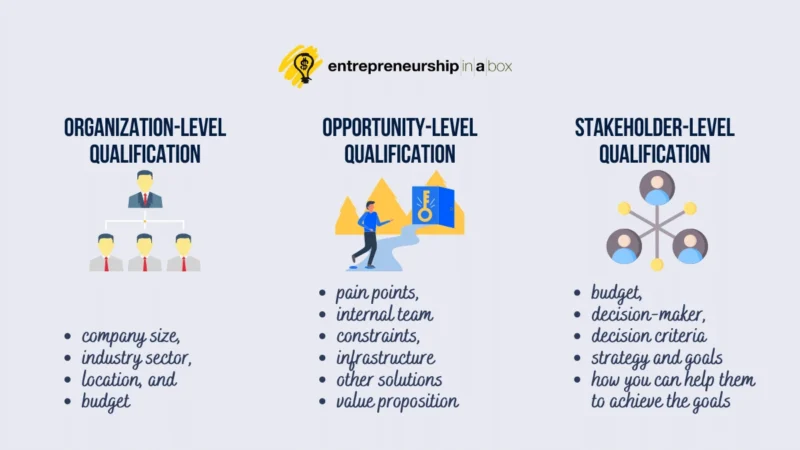
Lead Qualification Frameworks
Your sales team can use different qualification frameworks or methodologies to assess leads and discover hot leads. Some popular ones include:
- BANT: Stands for Budget, Authority, Need, and Timeline. This framework helps determine if a lead has the financial resources (budget), decision-making authority, need for your product or service, and a specific purchase timeframe.
- CHAMP: Stands for CHallenges, Authority, Money, and Prioritization. This approach focuses on understanding the lead’s challenges and pain points, their decision-making authority, the budget (money they are ready to spend), and the priority of solving the problem.
- MEDDIC: Stands for Metrics, Economic Buyer, Decision Criteria, Decision Process, Identify Pain, and Champion. This methodology emphasizes understanding the quantifiable metrics the lead uses to measure success, the economic buyer (who is responsible for the budget), the criteria and process for decision-making, the lead’s pain points, and identifying a champion within the organization.
- ANUM: Stands for Authority, Need, Urgency, and Money. This framework prioritizes leads based on their decision-making authority, the need for your product or service, the urgency of their problem, and their budget.
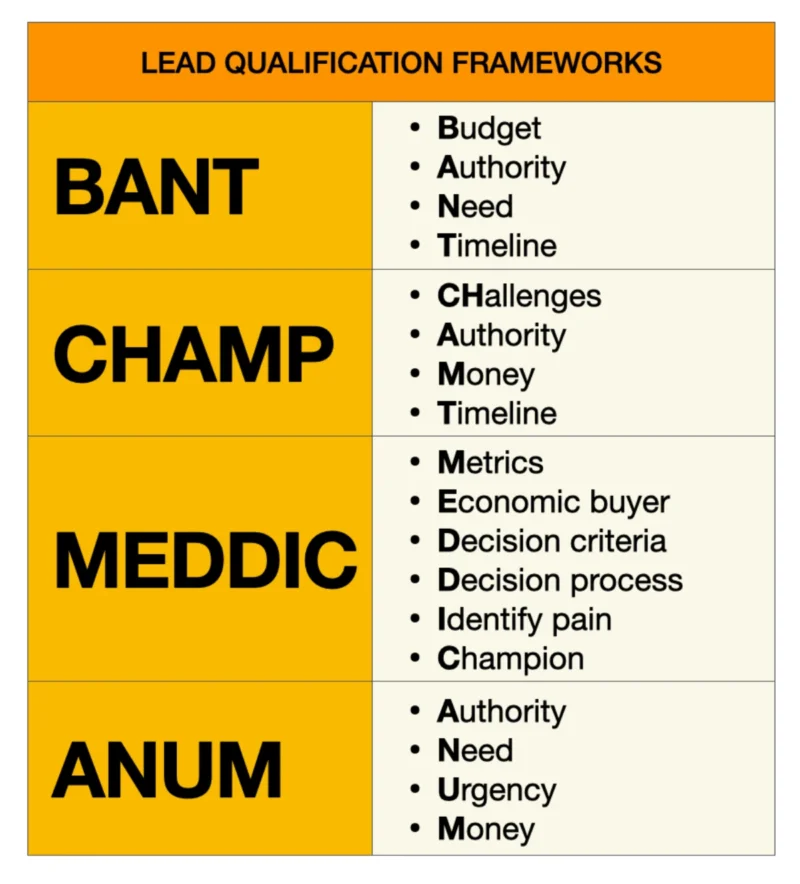
30 Places to Find Prospects & Leads for Your Business
Now, let’s go with the places where you can find prospects and leads for your business. So, here we will talk about different places and sales techniques related to getting prospects for your company.
Social Media Channels
Social media has a vast user base which presents a great opportunity to connect with people and form relationships. Whether you prefer paid or organic strategies, you can leverage social media to find and engage with your leads.
Let’s look at some of the best ways you can tap into these networks to generate more prospects for your business.
1. Facebook
Facebook Groups and Business Pages are excellent ways to discover prospective customers with common interests or pain points.
👇 To-do List
Join industry-related Facebook Groups and contribute valuable advice or insights related to your industry to position yourself as an expert.
Create a Business Page to showcase your products or services and engage with your target audience.
Use Facebook Ads to reach a wider audience and generate targeted leads.
2. Twitter
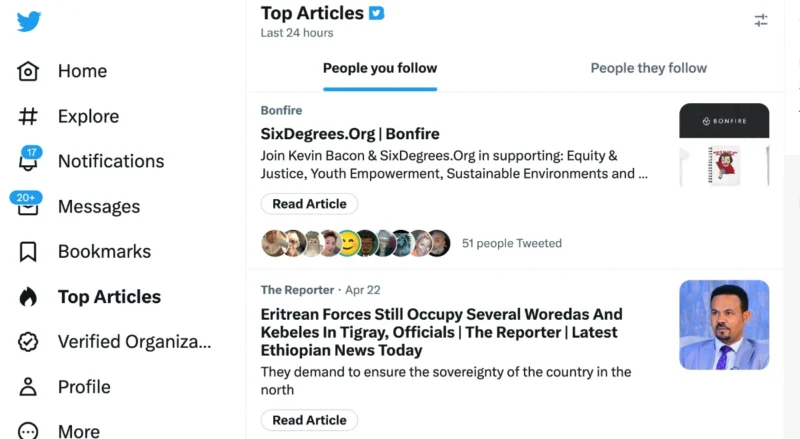
Twitter is a fantastic platform for sales prospecting. By following industry influencers and monitoring relevant hashtags, you can uncover a potential prospect and join in on conversations that matter.
👇 To-do List
Follow industry influencers, potential prospects, and hashtags relevant to your niche.
Share valuable content and engage with your target audience by replying to tweets and retweeting.
Use Twitter’s advanced search to find conversations and prospects in your target market.
3. Instagram
With its visual appeal and the power of hashtags, Instagram allows you to showcase your products and connect with potential customers more creatively and engagingly.
👇 To-do List
Create an eye-catching, professional-looking Instagram profile highlighting your company’s unique offerings.
Use relevant hashtags and location tags to increase visibility and attract potential prospects.
Engage with your target audience by responding to comments, liking, and following their accounts.
4. LinkedIn
LinkedIn is a professional networking platform that can help you find prospective customers and connect with key decision-makers.
👇 To-do List
Build your LinkedIn network by connecting with your target audience, industry peers, and mutual connections.
Engage with relevant content, participate in industry-specific groups, and share valuable insights to grab the attention of prospects.
Use LinkedIn’s advanced search filters to identify potential buyers and send personalized connection requests or InMail messages.
5. Youtube
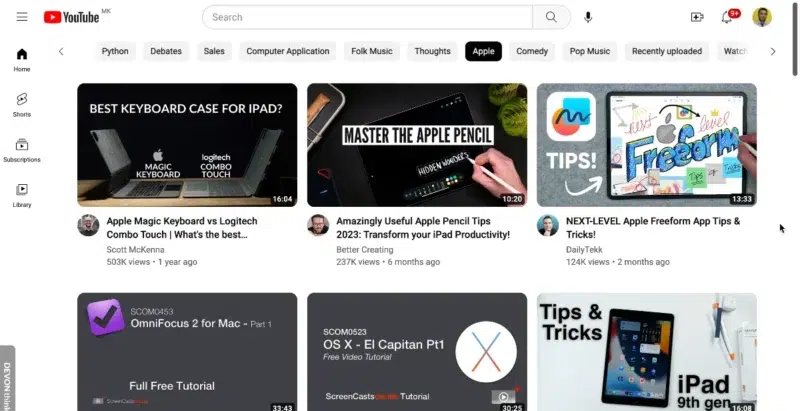
YouTube is a treasure trove of engaging content and potential customers. It can be an incredibly potent platform for sales prospecting.
👇 To-do List
Create a YouTube channel for your business and fill out the “About” section with relevant information, a concise description of your expertise, and a link to your website or other social media profiles.
Start creating valuable content. Think about your target market’s pain points and interests and create videos addressing those topics. This could be in the form of how-to guides, industry news, or even interviews with experts in your field.
Engage with your viewers by responding to comments, asking for feedback, and encouraging them to subscribe to your channel.
Include clear calls-to-action (CTAs) in your videos, encouraging viewers to visit your website or sign up for your newsletter. Additionally, provide links to relevant resources, products, or services in your video descriptions to make it easy for interested viewers to learn more about your offerings.
Promote your videos on other social media and within relevant online communities.
Networking & Events
Networking and events are great places to find prospects and leads for your business. Whether attending an industry conference or networking with prospective customers at a local meetup, it’s essential to make the most of these opportunities.
Related: 5 Benefits of Using People Search Engine
6. Local business meetups
Local business meetups are an excellent way to connect with potential customers and build meaningful relationships. You can engage in conversations, get insight into the needs and wants of your target audience, and create opportunities for referrals that could lead to new leads for your small business.
👇 To-do List
Find local business meetups through platforms like Meetup or Eventbrite, and attend regularly.
Be genuine in your interactions, focusing on building relationships rather than just selling your product or service.
Exchange business cards or contact information and follow up with potential prospects after the event.
7. Industry conferences
Industry conferences brought together professionals, experts, and prospective customers, creating the perfect environment for sales prospecting and learning about the latest trends in my industry.
👇 To-do List
Research industry conferences relevant to your business and invest in attending.
Prepare an elevator pitch that clearly communicates your company’s mission and value.
Network with attendees, exhibitors, and speakers, and follow up with potential leads after the event.
8. Webinars

By sharing valuable information and insights through webinars, you will establish yourself as an expert in your field while generating business leads.
👇 To-do List
Choose a relevant and engaging topic that will appeal to your target audience.
Promote your webinar through social media, email marketing, and other channels.
Capture attendees’ contact information and follow up with them after the event to discuss potential business opportunities.
9. Alumni associations
Tapping into your alumni network can be an unexpected goldmine for your business. Some of your former classmates and university connections can be valuable resources for potential leads and referrals.
👇 To-do List
Join your university’s alumni association and attend events to reconnect with old classmates and make new connections.
Share updates about your business and inquire about potential opportunities within your alumni network.
Offer to speak at alumni events or contribute content to the alumni newsletter to increase your visibility.
10. Community events
Remember that local community events can lead to new business opportunities. Whether it was a charity fundraiser or a neighborhood block party, these events are a great way to meet potential customers and showcase your company’s commitment to the community.
👇 To-do List
Attend community events and engage with people to learn more about their needs and interests.
Sponsor or participate in local events to increase brand visibility and showcase your company’s values.
Build relationships with other local businesses and community leaders to create a network of mutual support and referrals.
Online Communities and Forums
Online communities and forums are great places to find prospects. Taking advantage of these digital spaces can be a great way to generate new leads while also building relationships with current customers or clients.
11. Reddit
Reddit can be an excellent source of prospective customers for your small business. You can join conversations, share expertise, and establish credibility with potential prospects there.
👇 To-do List
Identify subreddits that are relevant to your industry and target audience.
Engage in discussions by providing valuable insights and answering questions.
Avoid self-promotion; instead, focus on being helpful and informative to build trust within the community.
12. Quora
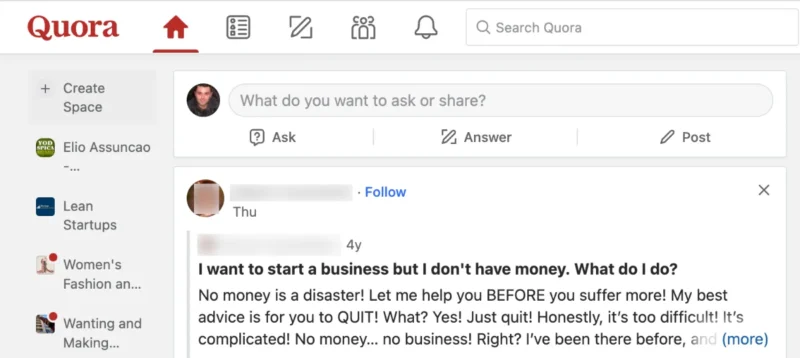
Quora is a question-based social media platform and is a goldmine of knowledge and potential customers. It can be an incredibly powerful platform for sales prospecting efforts.
👇 To-do List
Create an excellent profile that highlights your expertise and background. Add a professional photo and bio that speaks to your target audience.
Find possible questions relevant to your industry or niche.
Spend time answering questions daily, offering valuable insights, and sharing your experience. The goal is to be genuinely helpful, not to sell something!
Engage with potential customers by upvoting their answers, leaving thoughtful comments, and asking follow-up questions.
13. Industry-specific forums
Participating in an industry-specific forum can give you a better understanding of the industry, enabling you to target potential prospects and leads more effectively.
👇 To-do List
Do your own research and join industry-specific forums that align with your target audience.
Participate in discussions, and offer valuable advice and insights to build credibility and authority.
Look for potential leads by identifying users who express interest in products or services similar to your offering.
14. Slack community chapters
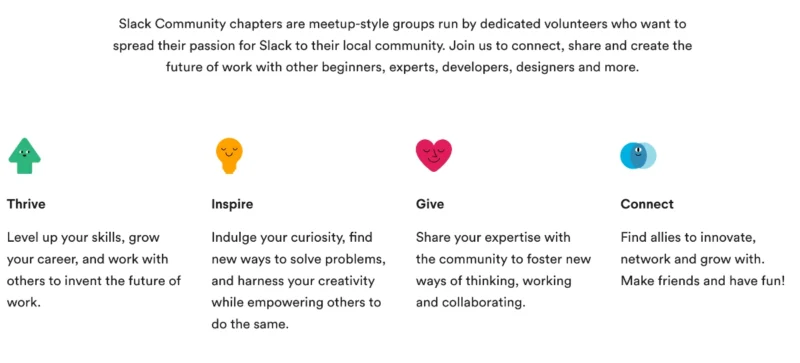
Slack community chapters are groups organized and managed by volunteer advocates passionate about bringing Slack’s power to their local communities. This is an excellent opportunity to connect with other members. Through these meetings, participants can share ideas and experiences that will help transform the future of work.
👇 To-do List
Search for and join relevant Slack communities related to your industry or target audience.
Engage in conversations and share valuable insights, positioning yourself as an expert.
Look for potential prospects by identifying users who express interest in products or services similar to your offering and initiate private conversations to explore opportunities.
15. GrowthHackers
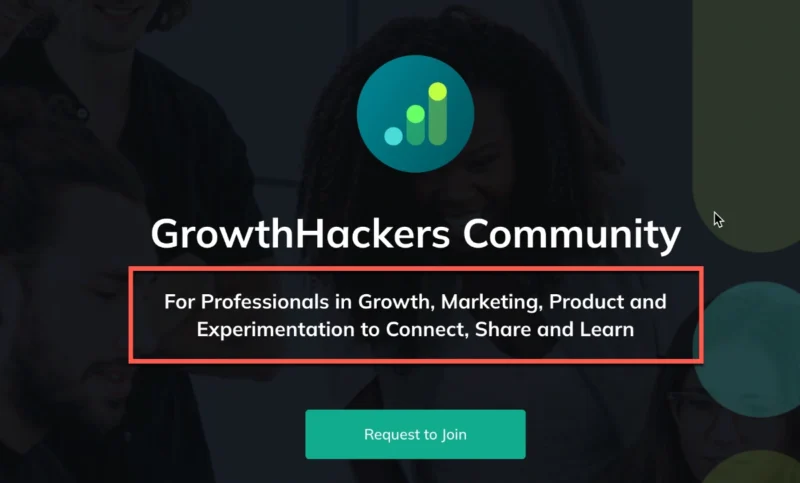
GrowthHackers is a community of “growth, marketing, product, and experimentation professionals.” With its powerful search and analytics engine, you can quickly identify profitable growth opportunities. GrowthHackers can be an invaluable tool to scale your business quickly and effectively.
👇 To-do List
Create a complete and engaging profile on GrowthHackers.
Share insightful articles, case studies, and resources related to your niche.
Participate in discussions by leaving thoughtful comments on other members’ posts, asking questions, and providing your own insights.
Start or join AMAs (Ask Me Anything) sessions to host or participate in AMAs within your niche.
Connect with fellow GrowthHackers members who share your interests or work in your target market. Building relationships with other professionals can lead to referrals, collaborations, and potential prospects for your business. Be sure to follow up and maintain these connections over time.
Marketing Campaigns
Marketing campaigns are essential to transforming new leads into prospects and then buyers. You can reach your target audience cost-effectively while also helping you build brand awareness and loyalty. With the right strategy, your campaigns can effectively help you generate leads.
16. Email marketing
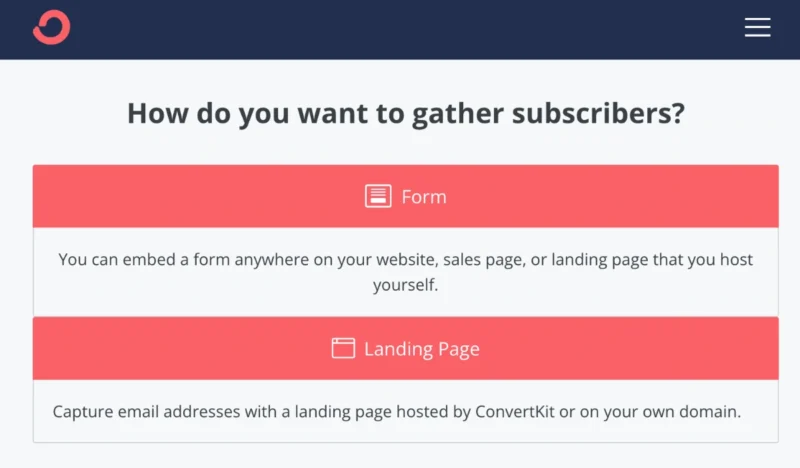
Email marketing is an important part of each lead-generation process. By crafting personalized and engaging emails, you will nurture a lead and ultimately convert him into paying customer.
👇 To-do List
Build a targeted email list by offering valuable lead magnets on your website using different tools for marketing automation.
Craft attention-grabbing subject lines to improve open rates.
Personalize your emails and provide helpful content addressing your prospect’s pain point.
Track your results and adjust your strategy to improve engagement and conversions.
17. Content marketing (blogs, podcasts, videos)
Content marketing is a key strategy for attracting customers for your sales pipeline. If you provide valuable and informative content that addresses your customer’s needs and interests, you can generate leads while you sleep.
👇 To-do List
Identify the types of content that resonate with your target audience (blogs, podcasts, videos, etc.).
Create high-quality, valuable, engaging content addressing your prospect’s pain point.
Promote your content through social media, email marketing, and other platforms to increase visibility.
Monitor your content’s performance and adjust your strategy to serve your audience better.
18. Google Ads
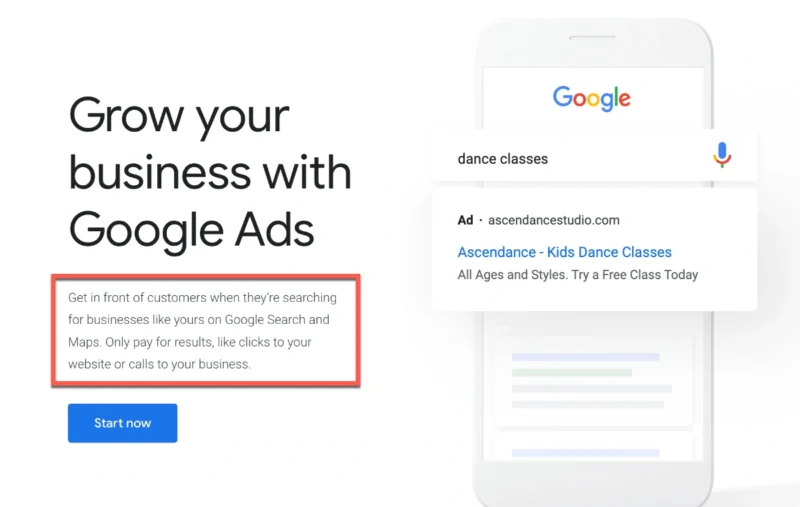
Google Ads is a powerful tool for businesses of all sizes to generate prospects for the sales pipeline. It allows you to target customers based on their search queries, interests, and demographics, effectively reaching qualified prospect actively looking for services or products like yours. With Google Ads, you can get your business in front of the right people at the right time – when they’re ready to buy. Plus, it offers flexibility in budgeting and targeting options so that whatever size of business or budget you have, something will work for you.
👇 To-do List
Set a budget that fits your business size and goals.
Target a qualified prospect by their search queries, interest-based audiences, location, language, and more.
Create text or display ads with compelling visuals and messaging to draw customers in.
Track your campaigns regularly to ensure they reach the right audience and deliver desired results. Make adjustments as needed to optimize effectiveness.
Test different campaigns and ad variations to see which ones perform best and adjust your strategy accordingly.
Use conversion tracking to measure the success of your campaigns and determine if you’re generating leads or prospects from them.
Analyze performance reports to see which campaigns are most successful, what type of customers they’re reaching, and how much you spend.
19. Influencer collaborations

Collaborating with influencers is a powerful way to find prospects. With the help of influencers in your target market, you can quickly reach prospects interested in what you offer. Influencer collaborations also help build trust and credibility for your brand and increase visibility and engagement on social media. With the right strategy, influencer collaborations can effectively generate prospects while growing your business.
👇 To-do List
Identify influencers within your industry with a strong following that aligns with your brand values.
Reach out to them with a collaboration proposal, highlighting the mutual benefits for both parties.
Develop a campaign that leverages the influencer’s unique strengths and audience to showcase your product or service.
Track the results of your influencer collaborations to measure their effectiveness and inform future partnerships.
20. Partnerships
Building partnerships with other businesses is probably the easiest and quickest way to reach prospects for your company. By collaborating with complementary businesses or organizations, you can expand your reach, increase credibility, and generate new leads for your business.
👇 To-do List
Identify potential partners who strongly connect to your target audience and share similar values or goals.
Develop a mutually beneficial proposal outlining both parties’ objectives and benefits.
Collaborate on joint marketing efforts, such as co-branded content, events, or promotions, to maximize exposure and leverage each other’s strengths.
Regularly evaluate the partnership’s success and seek ways to optimize the collaboration for even better results.
Traditional Outreach Methods
21. Direct mail
Although direct mail felt old-fashioned compared to digital marketing, the results still spoke for themselves. Your message will land directly in the hands of a sales lead, helping you to boost sales.
Related: 10 Unique Ways to Advertise Your Business
Using this direct advertising approach is a powerful way you can use for lead and prospect generation. This strategy allows you to target your message exactly where it needs to go and ensures that the right people receive it at the right time. Plus, with mail, you have complete control over design, content, and delivery – ensuring maximum impact on your target audience.
👇 To-do List
Research your target audience and create a mailing list of potential prospects.
Design eye-catching and engaging mailers that communicate your value.
Test different offers, messages, and subject lines to optimize results.
Track response rates and conversions to measure the success of your mail campaign.
22. Cold calling

Cold calling is a way companies have been doing for many years. It means you call people to tell them about what you are selling. Your sales reps will need to talk directly to the people who might want your products and services, so it helps you make more sales.
👇 To-do List
Prepare a strong opening statement that captures the prospect’s attention.
Develop a list of common pain points and questions to guide the conversation.
Use decision-maker names and personalization to build rapport.
Set goals for your number of calls and track your progress.
23. Print advertising
Print advertising may be an older method, but it’s still a powerful way to generate leads for your sales pipeline. Print advertising allows you to create eye-catching visuals that capture attention while communicating a clear value of what makes your product or service stand out from competitors.
👇 To-do List
Choose print publications that align with your ideal customer profile and industry.
Create visually appealing ads with clear messaging and a strong call to action.
Measure the success of your ads by tracking inquiries, leads, and conversions.
Experiment with different ad formats, sizes, and placements to optimize results.
24. Trade shows
Participating in trade shows can greatly benefit businesses by providing opportunities for networking, lead generation, and brand promotion. By showcasing your products and services, you can demonstrate your capabilities and appeal to your sales prospect in a targeted environment. Doing so lets you expand your professional network and meet new prospects.
👇 To-do List
Research relevant trade shows and exhibitions in your industry.
Plan and design an engaging booth that showcases your products or services.
Prepare marketing materials, such as brochures and business cards, to distribute at the event.
Network with attendees, follow up with leads and track the success of your trade show efforts.
25. Public speaking engagements

Public speaking not only does provide a platform for you to share your expertise but also gives you the opportunity to network with a specific sales prospect. By actively engaging in public speaking, you can reach out to a much wider audience than with other forms of marketing or networking events.
Standing in front of a room full of sales prospects and industry peers, you can position yourself as an expert and generate new leads for your business.
👇 To-do List
Identify relevant conferences, workshops, and events where you can share your expertise.
Craft a compelling presentation that addresses your audience’s pains and interests.
Practice your speech and work on your delivery to ensure you make a strong impression.
Network with attendees, collect contact information, and follow up with sales prospects after the event.
Referrals & Customer Engagement
To utilize the benefits of word-of-mouth, you can use referrals and engage with your customers. This involves leveraging your current customer network that connects with your brand. Also, by directly engaging with customers, you can establish relationships that foster trust and loyalty in the long run.
26. Existing Customers
One of the most effective ways to generate prospects is by leveraging current customers for referrals and engagement. Remember that your existing customers could be a goldmine of sales prospects. By nurturing relationships with them, you could ensure their continued loyalty and tap into their networks for potential new leads.
Engaging with current customers allows you to build relationships of trust and loyalty that will benefit both parties in the long run.
👇 To-do List
Develop a customer engagement strategy that strengthens relationships with current customers.
Request referrals from satisfied customers, offering incentives or rewards for successful leads.
Leverage customer success stories to create case studies and testimonials, demonstrating the value of your offering.
27. Testimonials & Case Studies

Testimonials can be used to showcase the success stories of current customers. At the same time, case studies provide detailed insights into how you solved problems or provided solutions for customers in the past. They are powerful tools that help a sales prospect recognize your value and see what it’s like to work with you. These social proof elements can also encourage existing clients to refer more people your way.
👇 To-do List
Collect testimonials and create case studies featuring your happiest customers.
Use these stories in your campaigns to illustrate the benefits of your offering.
Share testimonials on social media, your website, and other marketing channels to build credibility and trust.
28. Customer Appreciation Events
Customer appreciation events are a great way to show appreciation for current customers. Still, they can also be an effective tool for finding new leads. By planning creative customer appreciation events, you can gain more visibility in the local community and attract a sales prospect interested in your products or services.
👇 To-do List
Plan and host customer appreciation events to show gratitude and foster loyalty.
Use the event as an opportunity to network with customers and their connections, expanding your prospect pool.
Encourage guests to share their experiences on social media, increasing your brand visibility.
29. Joint Ventures with Other Businesses

Partnering with another business will help you tap into their existing customer base while leveraging each other’s resources to generate more leads and sales. This collaboration is a win-win situation for both parties. In such a way, your partner and you share the risks and rewards associated with marketing efforts.
👇 To-do List
Identify complementary businesses and explore potential joint ventures.
Collaborate on co-branded campaigns or events to reach a wider audience.
Share leads and referrals with your partner businesses to maximize the potential for new customers.
30. Employee Referrals
Employees can be among the most effective sources for lead generation and sales prospects. You can get potential new customers interested in your business using your existing employees’ networks.
👇 To-do List
Encourage your employees to refer potential clients from their personal networks.
Offer incentives or rewards for successful employee referrals.
Train your team to identify and qualify leads, maximizing the potential for successful conversions.
How to Use These Places Effectively
Remember that a one-size-fits-all approach wouldn’t work. Instead, you need to adapt your messaging and strategies for each platform or place we have mentioned here to increase your chances of connecting with sales prospects.
So, start by:
- Learning the nuances of each platform and tailoring your approach accordingly.
- Then, develop platform-specific messaging that resonates with your ideal customer profile and showcases your mission and value proposition.
- Test different strategies to determine which ones yield the best results on each platform.
- Focus on providing value and addressing pains when interacting with a sales prospect.
- Be genuine and authentic in your communication, allowing prospects to see the human side of your business.
- Prioritize long-term relationship-building over short-term sales gains.
- Implement a follow-up system to ensure no sales prospect falls through the cracks.
- Use a customer relationship management (CRM) tool to track interactions and set reminders for future communication.
- Regularly reach out to prospects and customers, providing value and updates on your company’s offerings.
Conclusion
To summarize, differentiating between leads and prospects is important in order to understand how to launch a successful sales prospecting process and gain high-quality clients for your business.
If your sales reps know the right places to look for prospects and how to use those places effectively are key elements in this lead qualification process. It may take some trial and error, but you will eventually succeed with the right action plan.
Whether it be through LinkedIn or email outreach campaigns, discovering these 30 places to find prospects will put you one step closer to acquiring profitable relationships for your business.
For more ideas on discovering valuable clients, keep exploring our website for additional resources!



